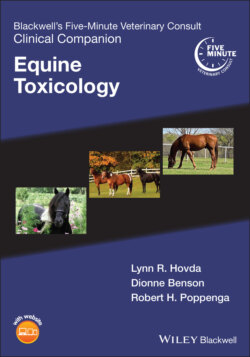Читать книгу Blackwell's Five-Minute Veterinary Consult Clinical Companion - Группа авторов - Страница 63
ОглавлениеChapter 6 Cobalt
DEFINITION/OVERVIEW
Cobalt is a trace element that is a necessary part of the equine diet.
There are no reported cobalt deficiencies in horses.
Cobalt is present in feed, supplements, and injectables that are marketed for equine use.
Cobalt is also purchased from compounding pharmacies.
Cobalt is used in the equine hindgut to make vitamin B12.
In humans, cobalt has been used to mimic hypoxia, stimulating RBC production.
In horses, no RBC production has been observed with IV administration of varying doses.
Intentional administration of excessive amounts of cobalt have led to toxicosis.
Controlled substance under ARCI rules.
ETIOLOGY/PATHOPHYSIOLOGY
Mechanism of Action
Unknown – in humans cobalt stabilizes HIF factors, causing increased erythropoiesis. Although studied, the same effects have not been observed in horses.
Toxicokinetics
Onset is rapid with effects occurring within minutes of IV administration.
Duration of action is minutes to hours for a single exposure. Repeated exposure effects have not been studied.
Absorption through the GI tract – in studies in sheep bioavailability varied by preparation. In horses, they are most often administered IV.
Hepatic metabolism: horses administered cobalt often have elevated concentrations in liver tissue.
Excretion – urinary excretion.
Toxicity
Highly toxic – clinical signs observed at doses as low as 0.25 mg/kg.
Toxic effects may vary by dose with some clinical signs observed more often at higher doses.
Systems Affected
Neurological – anxiety, ataxia, tremors, muscle fasciculations.
Cardiovascular – tachycardia, arrhythmias (including VT), increases in MAP, SAP, DAP.
Gastrointestinal – colic.
Renal – hematuria.
SIGNALMENT/HISTORY
Risk Factors
Iatrogenic administration.
Exposure to cobalt salts intended for other species (e.g., goats).
Historical Findings
Iatrogenic administration.
Owners or trainers may be reluctant to admit administration due to regulations.
Incidental exposure to cobalt salt intended for another animal.
Location and Circumstances of Poisoning
Worldwide problem, especially in racehorses.
Often intentional exposure in horse racing due to perceived increased erythropoietic effects.
Unintentional exposure by placement of cobalt salts, especially when co‐mingling of horses in pasture with animals requiring cobalt supplementation.
CLINICAL FEATURES
Variable by dose received.
Common signs include agitation, ataxia, muscle fasciculations, tachycardia, arrhythmias, hematuria, colic.
DIFFERENTIAL DIAGNOSIS
Colic of other etiology.
UTI or bladder stone for hematuria
Rhabdomyolysis.
HYPP.
WNV.
WEE, VEE, EEE.
Rabies.
DIAGNOSTICS
CBC/Serum Chemistry/Urinalysis
Routine laboratory work including serum chemistry and urinalysis.
Transient increase RBC for 1 hour post‐administration.
Mild increase in lactate and glucose within 1 hour of administration.
RBCs and urinary epithelial cells in urine.
± hypocalcemia.
Specialized testing for elevated cTnI within 24–48 hours of administration.
Other Diagnostic Tests
ECG as needed for tachycardia and cardiac effects.
Presence in serum and urine:No rapid, commercially available urine tests.ICP‐MS useful for diagnosis, but the time delay would hinder therapeutics.
Pathological Findings
No specific lesions reported in horses.
THERAPEUTICS
The goal of therapy is to provide supportive care.
Detoxification
Large ingestions – gastric lavage or reflux with large‐bore tube.
Supportive care if symptomatic.
Appropriate Health Care
Most can be treated in the field.
Most clinical parameters return to baseline within 2 hours.
Antidote
No specific antidote.
Drugs of Choice
IV fluids as needed for dehydration and volume expansion; may be helpful to increase elimination.
Agitation:Acepromazine 0.01–0.05 mg/kg IV, IM, SC prn.Adrenergic agonist: detomidine 10–40 μg/kg IM, IV or xylazine 0.5–1 mg/kg IV.
GI protectants:Omeprazole 2–4 mg/kg PO q24h.
Tremors, twitching:Acepromazine 0.01–0.05 mg/kg IV, IM, SC prn/Methocarbamol 4.4–22.2 mg/kg IV to effect. Administer half estimated dose and pause until the horse has relaxed. Administer the remainder of the dose to effect. Repeat as needed but do not exceed 330 mg/kg/day.
Precautions/Interactions
Protection to the head and limbs may be necessary in severely agitated horses.
COMMENTS
Client Education
There is no purpose for cobalt supplementation in horses.
ICP‐MS may be useful in legal cases.
Prevention/Avoidance
Educate trainers and owners about the adverse effects in horses.
Possible Complications
Acute kidney injury.
Cardiac damage.
Injury due to ataxia/colic.
Long‐term potential to cause arrhythmias resulting in sudden death.
Expected Course and Prognosis
Toxicity – for experimentally induced cases, prognosis is good with effects generally subsiding after 2 hours.
Fatality – prevalence of fatality in clinical cases is unknown as reports are limited.
Abbreviations
See Appendix 1 for a complete list.
Internet Resources
1 Racing Medication and Testing Consortium, Cobalt. Available at: https://rmtcnet.com/wp‐content/uploads/2015‐10‐Cobalt‐Brochure.pdf (accessed January 15, 2021).
2 European Food Safety Authority, Scientific Opinion on Safety and Efficacy of Cobalt Carbonate as Feed Additive for Ruminants, Horses and Rabbits. Available at: https://efsa.onlinelibrary.wiley.com/doi/pdf/10.2903/j.efsa.2012.2727 (accessed January 15, 2021).
Suggested Reading
1 Burns TA, Dembek KA, Kamr A, et al. Effect of intravenous administration of cobalt chloride to horses on clinical and hemodynamic variables. J Vet Intern Med 2018; 32:441–449.
2 Knych, HK, Arthur, RM, Mitchell MM, et al. Pharmacokinetics and selected pharmacodynamics of cobalt following a single intravenous administration to horses. Drug Test Anal 2015; 7:619–625.
Author: Dionne Benson, DVM, JD
Consulting Editor: Dionne Benson, DVM, JD
